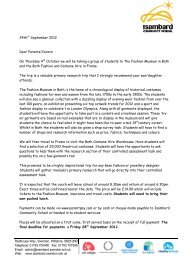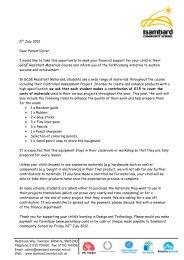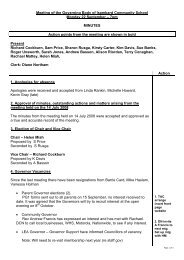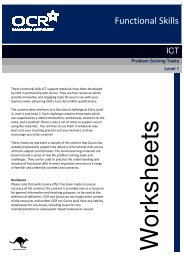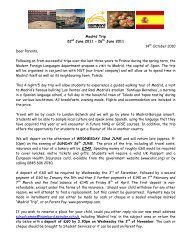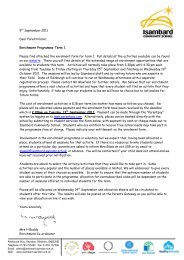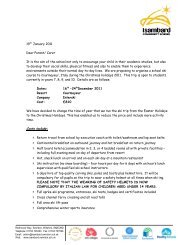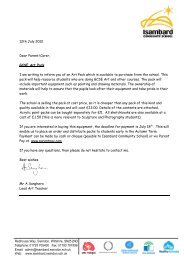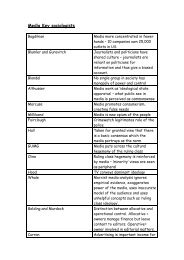Fabric Construction - Woven
Fabric Construction - Woven
Fabric Construction - Woven
You also want an ePaper? Increase the reach of your titles
YUMPU automatically turns print PDFs into web optimized ePapers that Google loves.
<strong>Woven</strong> fabrics<br />
How much do you already know<br />
about woven fabrics?<br />
Choose a number from 0=Not<br />
confident to 10=Very confident<br />
below<br />
0 1 2 3 4 5 6 7 8 9 10
Learning Objectives:<br />
• Be able to identify a woven<br />
fabric<br />
• Be able to name properties &<br />
characteristics of woven<br />
fabrics<br />
Learning Outcomes:<br />
• Be able to tell me how to<br />
create at least two different<br />
weaves<br />
• Have a good sample of each<br />
weave<br />
• Made detailed revision notes<br />
Success Criteria:<br />
A*-A: Be able to create<br />
different weave samples with<br />
no promoting from the<br />
teacher. Be able to speak and<br />
write fluently about woven<br />
fabrics in the lesson listing<br />
all properties and fabric<br />
characteristics confidently.<br />
B: Be able to create<br />
different weave samples and<br />
display a sound knowledge of<br />
their properties and<br />
characteristics.<br />
C: Be able to create<br />
different weave samples in<br />
the lesson with at least two<br />
properties and<br />
characteristics for each.
• Spinning is the<br />
twisting together of<br />
fibres to make a<br />
yarn. The more a<br />
yarn is twisted the<br />
stronger it will be.<br />
Weaving<br />
• A shuttle takes the<br />
yarn from one side to<br />
another.<br />
• <strong>Woven</strong> fabrics are not<br />
stretchy and tend to<br />
fray when cut.
Properties<br />
1. Edges do not fray<br />
until cut, as they<br />
have a selvedge<br />
1. They can be woven<br />
at different<br />
densities and have<br />
different weights<br />
4. The fabric is at its strongest on the grain<br />
line<br />
5. The fabric can stretch on the bias (diagonal)<br />
of the fabric.
<strong>Woven</strong> <strong>Fabric</strong> <strong>Construction</strong>.<br />
DRAW this diagram into your workbooks
<strong>Woven</strong> <strong>Fabric</strong> <strong>Construction</strong>.<br />
DRAW this diagram into your workbooks<br />
Make notes in workbooks<br />
WEFT<br />
The<br />
horizontal<br />
yarn is called<br />
the WEFT<br />
yarn ‘weft<br />
goes left!’ T
<strong>Woven</strong> <strong>Fabric</strong> <strong>Construction</strong>.<br />
DRAW this diagram into your workbooks<br />
WARP<br />
Make notes in workbooks<br />
The vertical<br />
yarn is called<br />
the WARP<br />
yarn ‘warp<br />
goes up and<br />
down!’ T<br />
The WARP<br />
yarn is also<br />
called the<br />
GRAIN<br />
LINET
<strong>Woven</strong> <strong>Fabric</strong> <strong>Construction</strong>.<br />
DRAW this diagram into your workbooks<br />
Make notes in workbooks<br />
At the edge of a woven<br />
piece of fabric the<br />
warp yarns wrap<br />
around the weft yarns,<br />
this is called the<br />
SELVEDGE<br />
Selvedge
<strong>Woven</strong> <strong>Fabric</strong> <strong>Construction</strong>.<br />
DRAW this diagram into your workbooks<br />
Make notes in workbooks<br />
If you put a tape<br />
measure diagonally<br />
across the fabric you<br />
are finding the BIAS.<br />
BIAS
• Plain weave –<br />
Types of weave<br />
Have a go!<br />
This is the simplest<br />
weave where one<br />
weft yarn passes<br />
under and over one<br />
warp yarn, e.g.<br />
poplin, calico.<br />
Teacher Demo
Types of weave<br />
Have a go!<br />
•Twill weave – Weft<br />
yarns pass under or over<br />
2–4 warp yarns.<br />
Herringbone is a variation<br />
on a twill weave. The<br />
fabric has a distinctive<br />
diagonal pattern, e.g.<br />
denim.<br />
Teacher Demo
•Satin weave –<br />
Types of weave<br />
Have a go!<br />
The weft yarns pass<br />
over between 4–7<br />
warp yarns to give<br />
smooth and shiny<br />
fabrics, e.g. damask.<br />
Teacher Demo
Peer Assessment Challenge<br />
Pass your work to a friend<br />
• Yellow Hat: What has gone well?<br />
• Black Hat: What has not worked so well?<br />
• Green Hat: How could it be improved?<br />
• Write your comments in their books, leaving space<br />
for sticking the woven samples in.
Pile weaves<br />
• Pile weaves can be made by<br />
inserting extra warp threads<br />
into a plain weave backing.<br />
The loops can be cut (e.g.<br />
velvet) or left uncut (e.g.<br />
terry towel).<br />
• The extra yarns increase the<br />
surface area of the fabric<br />
which makes it more<br />
absorbent.<br />
• Pile weave fabrics include<br />
velvet, terry towel, corduroy.
<strong>Woven</strong> fabrics<br />
How much do you know NOW<br />
about woven fabrics?<br />
Choose a number from 0=Not<br />
confident to 10=Very confident<br />
below<br />
0 1 2 3 4 5 6 7 8 9 10
Questioning<br />
• Name two properties of woven fabrics<br />
• Name a fabric constructed using a plain,<br />
satin and twill weave<br />
• What is the name of the piece of equipment<br />
used to weave fabric in industry?<br />
• How are fibres made strong before<br />
weaving?<br />
• What is a pile weave?<br />
• What products can be made with a pile<br />
weave?





